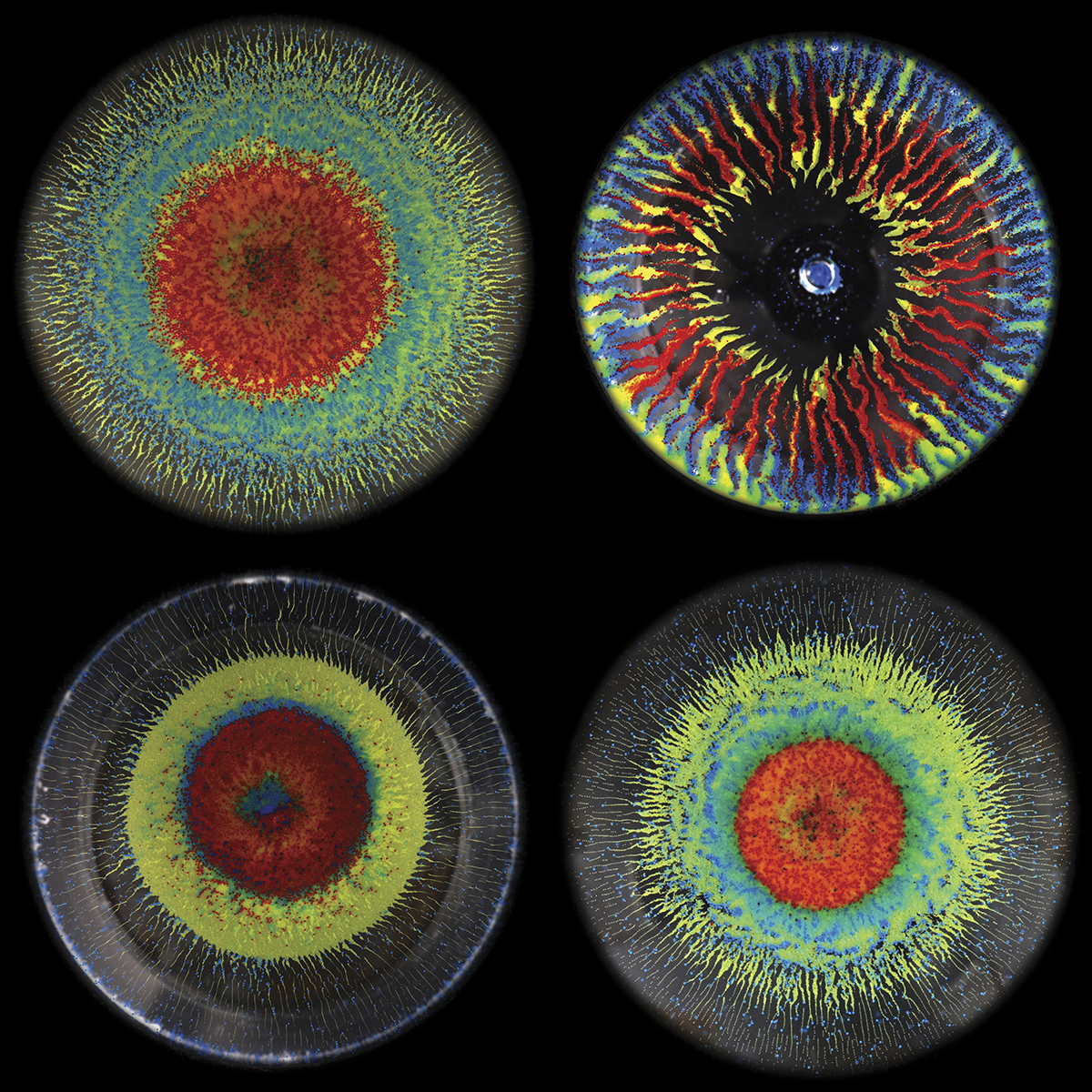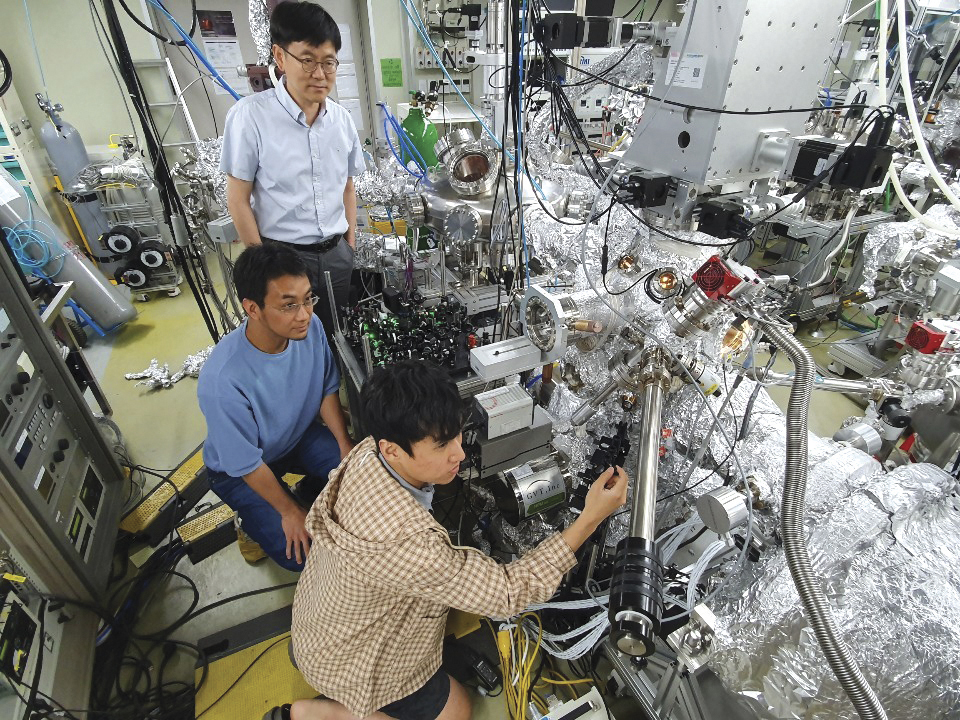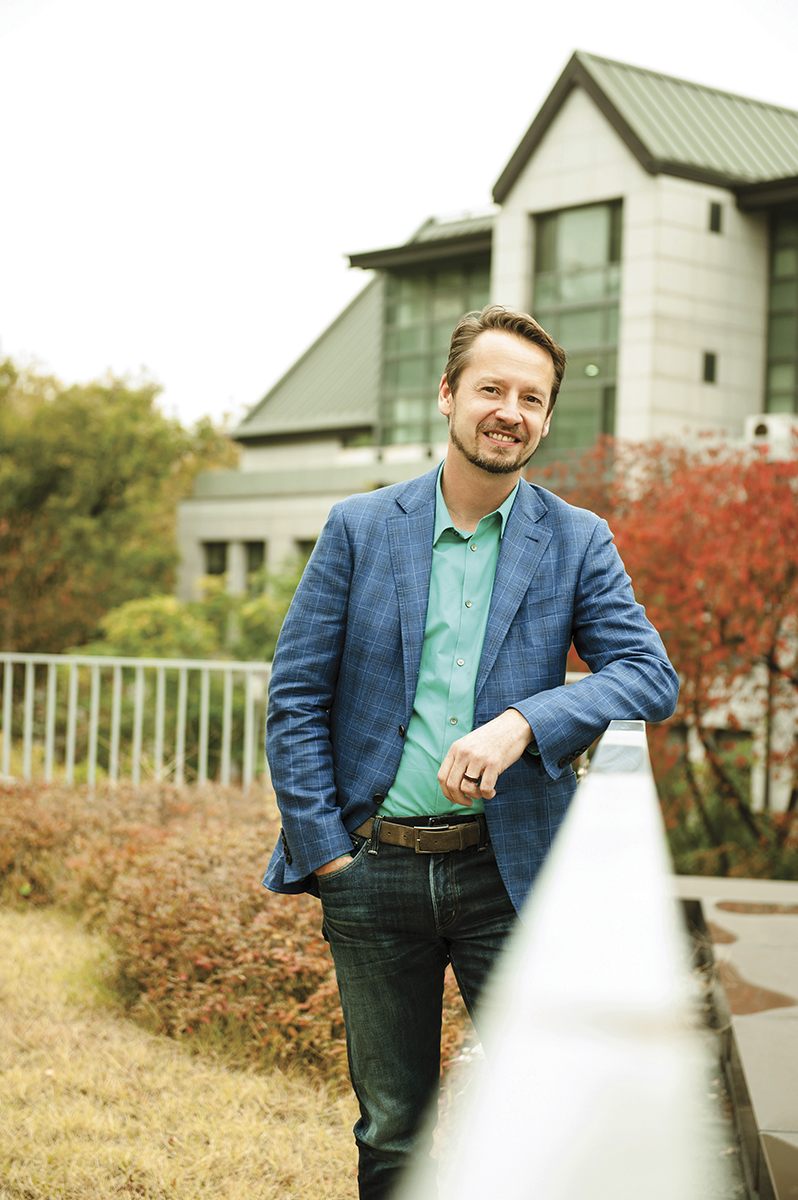Domestic quarrels cloud future of South Korea’s Institute for Basic Science
DOI: 10.1063/PT.3.4246
Since its founding in 2011, the Institute for Basic Science (IBS) in South Korea has largely lived up to its ambitious goals. It has attracted top scientists, produced world-class science, and made inroads in internationalizing the country’s research community. For continued success, however, the IBS must win over both the country’s other scientists and its current politicians and convince them that the big federal investment in a relatively small number of investigators is worthwhile.

Microparticles suspended in a rotating dense fluid self-organize into dynamic patterns. Researchers at the Institute for Basic Science Center for Soft and Living Matter in South Korea study these nonequilibrium systems to gain insight into symmetry breaking and pattern formation in rotational frames of reference. The four images are snapshots with different rotational histories; they show the same mixture of three kinds of polyethylene microparticles that differ in density, size, and color.
OLGIERD CYBULSKI AND BARTOSZ A. GRZYBOWSKI

When the IBS was created, South Korea had an impressive track record in applied science and manufacturing; the auto and electronics industries are examples. In launching the new initiative, the country’s then president Myung-bak Lee noted that countries at the forefront of science “have generated colossal national wealth on the strength of the achievements of basic research.” He said that for South Korea to “emerge as an advanced, leading nation … we need to become a creative pacesetter based on basic science and original technologies.”
And so the IBS was born. It was tasked with creating 50 research centers on a $600 million budget in its first five years (see Physics Today, October 2012, page 26
Now the IBS is approaching a delicate juncture. In recent years the government has eroded the centers’ budget and autonomy. And evaluations in the next year will determine whether the eight oldest centers will continue beyond 10 years. Those evaluations have many of the IBS directors on edge; the results will set the tone for the institute’s future.
“We are not held back”
The IBS currently consists of 30 centers across many scientific disciplines. Research topics are generally determined by the scientists, although some directors have been brought on to work in a specified thematic area. About one-quarter of the roughly 700 IBS researchers are foreigners, and a similar portion are women.
“We haven’t grown as fast as we planned,” says Se-Jung Oh, a condensed-matter physicist who served as the IBS’s founding president. In some years no new centers were established; the most recent ones were started in 2017. Last year the IBS did launch two “pioneer” centers, a new model led by junior scientists with about one-quarter the budget and a shorter intended lifetime than the centers led by more senior scientists. “At least one or two full-scale centers should be established each year to signal to the world that the IBS is still growing,” says Oh.
The center directors set the tone for the research and the organization. Steve Granick, who heads the IBS Center for Soft and Living Matter, strives to create a flat management structure and to hire scientists who are “creative, curious, get along with me, and have their own ideas.” The chance to “have a new life scientifically and explore a new culture” lured him away from his 30-year tenure at the University of Illinois, he says. “The audaciousness of the IBS is amazing. Almost all of us are working on things that we were not working on before. We are not held back.”

Scientists at the Center for Correlated Electron Systems are developing new laser systems. Student Yoonshik Kim (foreground) aligns laser optics, as Yukiaki Ishida (middle), a collaborator from Japan, and center associate director Changyoung Kim (back) look on. The center is one of 30 launched by South Korea’s Institute for Basic Science.
CHANGYOUNG KIM

Yeongduk Kim is director of the IBS Center for Underground Physics, which has 65 researchers who are trying to identify dark matter and studying various aspects of neutrinos, such as whether they are their own antiparticles. The center is building a new underground lab about 1100 meters deep to shield it from cosmic-ray interference. The lab is slated to open in 2021 and will house a double- beta-decay experiment, a multipurpose scintillator for neutrino studies, and a scintillating crystal experiment with which, Kim says, “we will try to pinpoint low-mass dark-matter candidates.”
Axel Timmermann moved in 2017 from the University of Hawaii to start the IBS Center for Climate Physics at Pusan National University. Two professors from the host university joined the center, and Timmermann is looking to hire three more. His center has enough money to employ 50 people. He and his colleagues use their supercomputer—the third-fastest in the country—to simulate future climate change and past ice ages. One goal is to predict the degree to which melting ice sheets will contribute to rising sea levels.
Another area of research at the center is how climate change affected past human migration and evolution. For that, Timmermann collaborates internationally with archaeologists, anthropologists, and geneticists. In addition to simulations, the project isotopically analyzes stalagmite samples collected from caves in South Korea. “The goal of the IBS is to do transformative research, stuff I can’t do anywhere else. I am extremely happy that I can explore scientific frontiers and fringes that might be too risky for most places,” he says.
Growing tensions
Resentment toward the IBS is growing, however, in South Korea’s wider scientific community. Scientists at the centers have more funding than is available through individual investigator grants, and their funding is more stable and flexible. “The biggest risk to the IBS is from inside the country,” says Andreas Heinrich, who leads the IBS Center for Quantum Nanoscience. “University scientists ask, ‘Why should some people get more money? Why should Korea spend money on foreigners?’ ” The IBS was started with new money, but there is still a sense that the pie is not divvied up fairly.
The genesis of IBS exacerbates that envy. “It was initiated by a very small number of people and backed by a strong political decision,” says Han Woong Yeom, director of the IBS Center for Artificial Low Dimensional Electronic Systems. “We need stronger research groups if we want to compete with emerging groups in China and other countries,” he says. “But we had no good discussion within our scientific community about the needs and structure and identity of the IBS,” he says. “This is generating more trouble as time passes.”

Andreas Heinrich moved to South Korea from IBM Research–Almaden in California in 2016 to start the Institute for Basic Science Center for Quantum Nanoscience, which is housed at the Ewha Womans University in Seoul.
ANDREAS HEINRICH

“Resistance from the university science community is natural. They think it will weaken their position,” says Peter Fulde, a former director at the Max Planck Institute for the Physics of Complex Systems in Dresden, Germany, and one of 25 members of the IBS scientific advisory board. “The same phenomenon happened when the Max Planck Society’s predecessor, the Kaiser Wilhelm Society, was formed in 1911.” It’s crucial to appoint outstanding scientists as directors, he says, and to give the new institute time to mature. Fulde says the IBS is so far living up to expectations. He recommends stable budgets, inclusion of more graduate students, stronger ties to the international community, and autonomy for center directors.
The South Korean government has changed twice since the IBS was formed. Due to the different policies of the parties in power and in response to grumbling from the country’s broader scientific community, the growth of the IBS budget hasn’t kept up with the increasing number of centers. Individual center budgets have decreased from an annual average of about $8.4 million early on to about $5.2 million this year. And since last year the government has required details of how centers use their funding, and officials say the directors have had too much flexibility, according to Yeom.
A rare isotope and heavy-ion facility, RAON, in the works in South Korea further confuses the situation. Both RAON and the IBS are part of a larger scheme called the International Science and Business Belt, and the IBS oversight of the $1.2 billion facility adds to the perception of money going to a select group of researchers, even though the accelerator is a separate project, says IBS president Doochul Kim. Slated to open to users in 2021, RAON has become something of an albatross for South Korea’s science community and the IBS.
In an effort to appease non-IBS scientists, the South Korean government is doubling grant money for individual investigators over a five-year period, from about $1 billion in 2017 to $2 billion in 2022. In 2017 the country’s total budget for basic research was $4.5 billion. The IBS received about $200 million. IBS scientists can’t compete for grant money.
One IBS aim is for the methods and level of research at the centers to spill over into the country’s wider scientific community. Many of the IBS facilities—including synchrotron beamlines, electron microscopes, and supercomputers—are open to other users. Some IBS center directors host workshops and conferences and pay for domestic students and faculty to attend. And some, like Yeom, hire young faculty members to help them launch their careers and to integrate them into the international groups—which tend to be less hierarchical than traditional research arrangements in the country. The IBS is the country’s first scientific institution to be rated through a peer-review-based international assessment process. “The IBS is influencing the broader community,” says Tae Won Noh, director of the Center for Correlated Electron Systems. “For example, the postdoc system is improving.”
“The IBS has an identity problem,” says Yeom, and the onus is on the directors to demonstrate that the institute is worth supporting. “What are the qualifications for a director? What distinguishes the role of IBS scientists from other researchers? And what is the optimal budget for an IBS center? Those questions need answers,” Yeom says. An IBS center should do things that individuals cannot. The synergies among the researchers and the scale of the facilities should add up to more than the sum of the parts, says Heinrich. “The IBS is especially important for large projects and things that can’t be done by single investigators,” he adds.
The IBS has “changed the paradigm of basic science” in South Korea, says the institute’s president. “We often say it is a miracle that the IBS was realized at all.” But it’s a challenge, he says, to persuade policymakers to keep the original philosophy of the IBS, in which top scientists are given the resources and rein to pursue their ideas. Many variations for the future of the IBS are floating around, he adds. “The country needs to think seriously about what to do in the next five or 10 years.”
More about the Authors
Toni Feder. tfeder@aip.org
